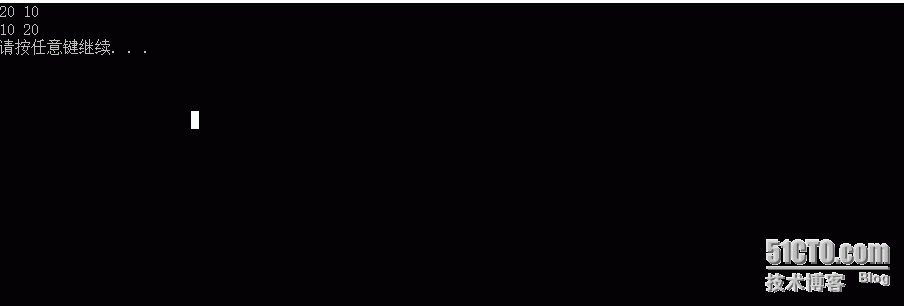学习链表是为了更好的学习c++;顺序链表又是最简单的链表。顺序链表在实现的时候有些需要注意的事情。
实现顺序链表初始化,尾部插入,尾部删除,头部插入,头部删除,选择位置插入,查找,删除某个位置上的数,删除一个。
一.首先让我们将定义一个结构体
typedef struct SeqList
{
DataType array[MAX_SIZE];
size_t size;
}SeqList; 可以发现我在上面使用了宏和typedef。
typedef int DataType;
#define MAX_SIZE 5 好处:1.需要将数组的大小改变的时候,直接改变宏的地方。
2.可以随意改变数据类型。
二.让我们来写出来上面函数的声明
void InitList(SeqList *pSeq);
void PushBack(SeqList *pSeq,DataType x);
void PopBack(SeqList *pSeq);
void PrintfList(SeqList *pSeq);
void PushFront(SeqList *pSeq, DataType x);
void PopFront(SeqList *pSeq);
void Insert(SeqList *pSeq, size_t pos, DataType x);
int Find(SeqList *pSeq, DataType x);
void Erase(SeqList *pSeq, size_t pos);
void Remove(SeqList *pSeq, DataType x);
void RemoveAll(SeqList *pSeq, DataType x); 1.声明为指针
如果声明为结构体变量,那么在传参的时候会考进来一份临时拷贝,改掉的并不是真正的结构体数组中的值。可以用一个小程序来验证。
#include<stdio.h>
void fun(int a,int b)
{
int z = a;
a = b;
b = z;
printf("%d %d\n", a, b);
}
int main()
{
int a = 10;
int b = 20;
fun(a, b);
printf("%d %d\n", a, b);
system("pause");
return 0;
} 为什么两个打印的结果不一样?
直接说原因,因为传参的时候考了两份临时变量给了fun函数导致在fun函数内部更改的不是内存中保存a和b的值。同样的道理,在顺序链表中,就会存在这样的问题。那么,声明为指针,传参的时候将地址传过来,在函数的内部直接操作内存就是一种很方便的方法。
二.实现函数
1.初始化
void InitList(SeqList* pSeq)
{
assert(pSeq);
memset(pSeq->array, 0, sizeof(DataType)*MAX_SIZE);
pSeq->size = 0;
} 2.尾部插入
void PushBack(SeqList* pSeq, DataType x)//尾插
{
assert(pSeq);
if (pSeq->size >= MAX_SIZE)
{
printf("full\n");
return;
}
pSeq->array[pSeq->size] = x;
pSeq->size++;
//Insert(pSeq, pSeq->size, x);
} 3.尾部删除
void PopBack(SeqList* pSeq)//尾删
{
assert(pSeq);
if (pSeq->size <= 0)
{
printf("empty\n");
return;
}
pSeq->size--;
}4.头部插入
void PushFront(SeqList *pSeq, DataType x)//头插
{
assert(pSeq);
int begin = pSeq->size - 1;
if (pSeq->size >= MAX_SIZE)
{
printf("full\n");
return;
}
for (; begin >= 0; --begin)
{
pSeq->array[begin+1] = pSeq->array[begin];
}
pSeq->array[0] = x;
++pSeq->size;
}5.头部删除
void PopFront(SeqList *pSeq)//头删
{
assert(pSeq);
int begin = 1;
if (pSeq->size <= 0)
{
printf("empty\n");
return;
}
int i = pSeq->size;
for (; begin < pSeq->size; ++begin)
{
pSeq->array[begin-1] = pSeq->array[begin];
}
pSeq->size--;
}6.选择位置插入(两种写法)
void Insert(SeqList *pSeq, size_t pos, DataType x)
{
//[]
// assert(pSeq);
// assert(pos <= pSeq->size);
// int begin = pSeq->size - 1;
// if (pSeq->size >= MAX_SIZE)
// {
// printf("full\n");
// return;
// }
// for (; begin >= (int)pos; --begin)
// {
// pSeq->array[begin + 1] = pSeq->array[begin];
// }
// pSeq->array[pos] = x;
// ++pSeq->size;
//
//(]
assert(pSeq);
assert(pos <= pSeq->size);
int begin = pSeq->size;
if (pSeq->size >= MAX_SIZE)
{
printf("full\n");
return;
}
for (; begin > pos; --begin)
{
pSeq->array[begin] = pSeq->array[begin - 1];
}
pSeq->array[pos] = x;
++pSeq->size;
}7.查找
int Find(SeqList *pSeq, DataType x)
{
assert(pSeq);
int i = 0;
for (; i < pSeq->size; ++i)
{
if (pSeq->array[i] == x)
{
return i;
}
}
return -1;
}8.删除某个位置上的数
void Erase(SeqList *pSeq, size_t pos)//删除某个位置的数据
{
assert(pSeq);
assert(pos <= pSeq->size);
int begin = pos+1;
for (; begin <= pSeq->size; ++begin)
{
pSeq->array[begin - 1] = pSeq->array[begin];
}
--pSeq->size;
}9.打印链表
void PrintfList(SeqList* pSeq)//打印链表
{
assert(pSeq);
int i = 0;
for (i = 0; i < pSeq->size; i++)
{
printf("%d ", pSeq->array[i]);
}
printf("\n");
} 10.写函数需要注意的问题
1).函数的参数的有效性检查
2).边界条件
3).实现逻辑
11.整形提升的问题在实现PopBack()函数时直接调用Insert()函数时候要尤其注意这个问题。
三.单元测试
//InitList()/PushBack()/PopBack()
void test1()
{
SeqList seq;
InitList(&seq);
PushBack(&seq, 1);
PushBack(&seq, 2);
PushBack(&seq, 3);
PushBack(&seq, 4);
PrintfList(&seq);
PopBack(&seq);
PrintfList(&seq);
}
//InitList()/PushFront()/PopFront()
void test2()
{
SeqList seq;
InitList(&seq);
PushBack(&seq, 1);
PushBack(&seq, 2);
PushBack(&seq, 3);
PushBack(&seq, 4);
PrintfList(&seq);
PushFront(&seq,0);
PushFront(&seq, -1);
PrintfList(&seq);
PopFront(&seq);
PrintfList(&seq);
}
void test3()
{
SeqList seq;
InitList(&seq);
PushBack(&seq, 1);
PushBack(&seq, 2);
PushBack(&seq, 4);
PushBack(&seq, 5);
Insert(&seq, 2, 3);
Insert(&seq, 2, 3);
PrintfList(&seq);
}
void test4()
{
SeqList seq;
InitList(&seq);
PushBack(&seq, 1);
PushBack(&seq, 2);
PushBack(&seq, 2);
PushBack(&seq, 3);
PushBack(&seq, 4);
/*int ret = Find(&seq, 2);
printf("%d\n", ret);
Erase(&seq, 1);
PrintfList(&seq);*/
//Remove(&seq, 2);
RemoveAll(&seq, 2);
PrintfList(&seq);
}
int main()
{
test4();
system("pause");
return 0;
} 写大型项目的时候,单元测试是非常重要的,可以在实际开发中,避免问题的出现,并且易于定位问题,为调试修正bug提供线索。
以上就是本人在学习过程中的一些经验总结。当然,本人能力有限,难免会有纰漏,希望大家可以指正。
本文出自 “做一个小小小司机” 博客,请务必保留此出处http://10799170.blog.51cto.com/10789170/1727318





















 454
454

 被折叠的 条评论
为什么被折叠?
被折叠的 条评论
为什么被折叠?








